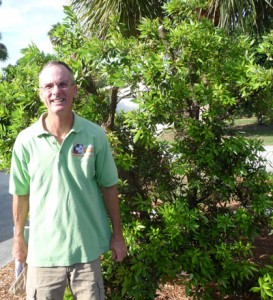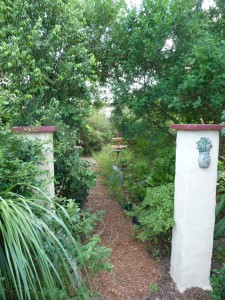Jeff Nurge went native eight years ago. He planted native flowers, bushes and trees in an effort to attract wildlife. You can’t really tell from the front – native trees and bushes are spaced apart. It is the sides and back of the house that get your attention.
Native plants attract birds and butterflies
These areas pulse with dense green foliage not unlike well, wild Florida.
Narrow paths make passing through possible. Seemingly random growth turns out to have specific lures for wildlife – a red bay, for example, has tiny flowers that bees love and the tree is a good shelter for birds.
“I wanted to see birds, snakes, owls, butterflies,” says the Delray Beach resident. And he does. In addition he wanted to conserve water. That too is happening.
A back fence has completely disappeared, hidden under flourishing firebush.
“This is a huge butterfly attractor,” Jeff comments. “Firebush is the number one native plant. This is the first plant to start with.”
I’m startled and surprised by what it means to go native. It means forget neat and manicured. This was once a conventional yard with grass underfoot and fence to mark the property line. Now it vibrates with exuberance and yes, a touch of chaos, all for a good cause – there is only so much space and so many natives to plant and so little time.
You see our wildlife is in trouble.
“So many landscapes are loaded with exotics,” notes Jeff. “They are beautiful but they are dead zones for wildlife. They have color and texture but where are the bees, the birds, the lizards?”
Native plants are good for water conservation
Dead zones? Beauty that kills here in Florida? Sounds like a science fiction novel but no, this is the real deal.
“The bird population and butterflies are not finding the food they need – the migrating birds need to feed in Florida to migrate to South America. If they can’t find the right food, they don’t make it.”
In my back yard, a haven with water fountains and bird feeders, or so I thought, the bird numbers have been dwindling in recent years. I was hoping they got a better offer and are happy somewhere else. Now I wonder if they made it from one year to the next.
Going native turns out to be a call to action – do you want to save native wildlife? Then turn your dead zone into a native buffet and you can do it one plant at a time. Before visiting Jeff I thought my side yard would become a fruit orchard. Now it is going native.
I planted firebush along the fence line. You go, you native you. Do your thing. The butterflies will love you.
RESOURCES
• Jeff recommends several native plant nurseries in his area including Pan’s Garden in Palm Beach, Meadow Beauty Nursery and Indian Trails Native Nursery, both in Lake Worth.
• “A Gardener’s Guide to Florida’s Native Plants” (paperback) by Rufino Osorio, here is the Amazon link and it is in our bookstore on my Website.
• Jeff, who is also a Master Gardener, has turned his native passion into a consulting business. Visit his Website to know more.
• Master Gardeners, an outreach program by IFAS University of Florida, may have an office near you. They can be immensely helpful, especially with micro irrigation and drought resistant plant suggestions.
• Florida Native Plant Society has chapters throughout the state.
• Here is the link for University of Florida IFAS Extension section on native plants. IFAS means the Institute of Food and Agricultural Sciences.
• Native plant nurseries will only flourish if people vote with their wallets and buy native. Here is a listing of native plant sources from Florida Gardener.
While milkweed is not a native it is the necessary larval plant for monarch butterflies. Learn more at the Live Monarch Foundation.
©2009 Lucy Beebe Tobias, all rights reserved.
MORE TO EXPLORE
Four travel journalists find great food on the open road

